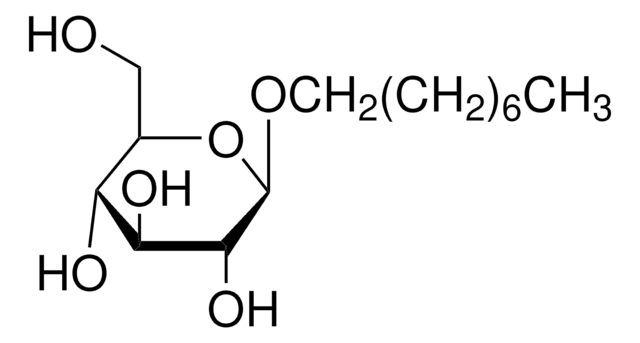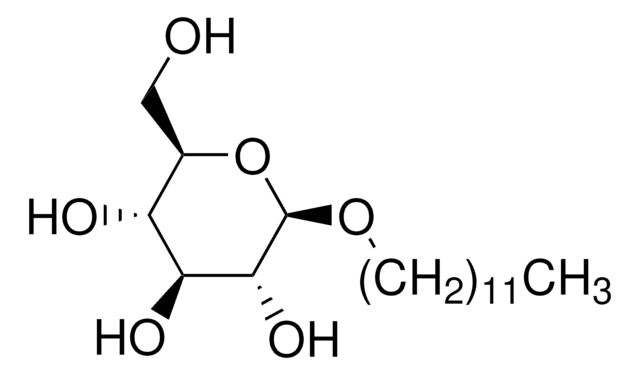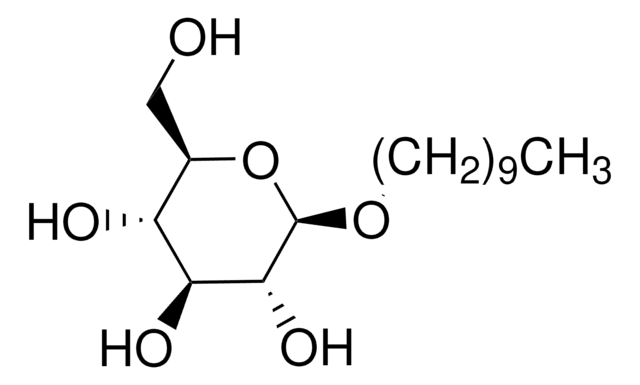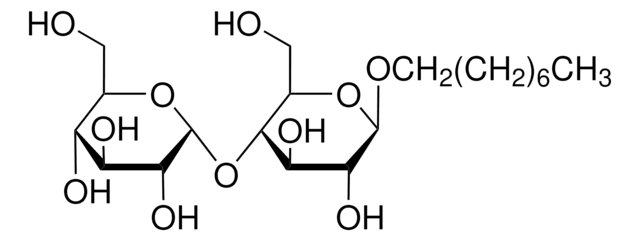Wichtige Dokumente
10634425001
Roche
n-Octylglucosid
non-ionic
Synonym(e):
Octyl-β-D-Glucopyranosid, n-Octyl-glucosid, OGP
About This Item
Empfohlene Produkte
Assay
99% (GC)
Mol-Gew.
micellar avg mol wt 25,000
292.4
Verpackung
pkg of 10 g
Hersteller/Markenname
Roche
Aggregatnummer
84
Methode(n)
dialysis: suitable
CMC
20-25 mM (20-25°C)
Übergangstemp.
cloud point >100 °C
Versandbedingung
ambient
SMILES String
CCCCCCCCO[C@@H]1O[C@H](CO)[C@@H](O)[C@H](O)[C@H]1O
InChI
1S/C14H28O6/c1-2-3-4-5-6-7-8-19-14-13(18)12(17)11(16)10(9-15)20-14/h10-18H,2-9H2,1H3/t10-,11-,12+,13-,14-/m1/s1
InChIKey
HEGSGKPQLMEBJL-RKQHYHRCSA-N
Suchen Sie nach ähnlichen Produkten? Aufrufen Leitfaden zum Produktvergleich
Allgemeine Beschreibung
Anwendung
Qualität
Ease of removal*: ++
CMC**: 14.5 mM at +25°C
Formula: C14H28O6
Angaben zur Herstellung
Working solution: Solubility: > 50% (w/v) in double-dist. water, Tris-HCl 0.05 mol/l; pH7.4 or K-phosphate buffer 0.1 mol/l, pH 7.0 at 25 °C.
Storage conditions (working solution): Stability in Solution
A stock solution is stable at 2 to 8 °C for approx. 3 days. We would expect a long term stability of 6-12 months if stored frozen in portions at -15 to -25 °C, provided bacterial contamination is avoided.
Lagerung und Haltbarkeit
Sonstige Hinweise
Lagerklassenschlüssel
11 - Combustible Solids
WGK
WGK 1
Flammpunkt (°F)
Not applicable
Flammpunkt (°C)
Not applicable
Hier finden Sie alle aktuellen Versionen:
Besitzen Sie dieses Produkt bereits?
In der Dokumentenbibliothek finden Sie die Dokumentation zu den Produkten, die Sie kürzlich erworben haben.
Kunden haben sich ebenfalls angesehen
Unser Team von Wissenschaftlern verfügt über Erfahrung in allen Forschungsbereichen einschließlich Life Science, Materialwissenschaften, chemischer Synthese, Chromatographie, Analytik und vielen mehr..
Setzen Sie sich mit dem technischen Dienst in Verbindung.











